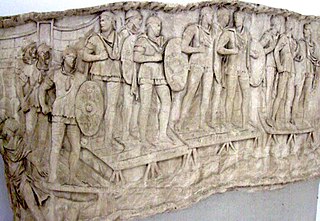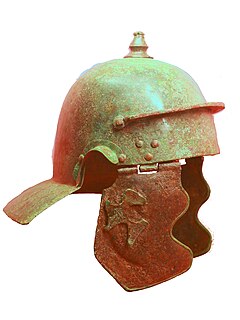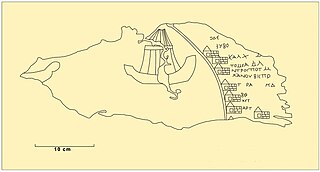A cohort was a standard tactical military unit of a Roman legion. Although the standard size changed with time and situation, it was generally composed of 480 soldiers. A cohort is considered to be the equivalent of a modern military battalion. The cohort replaced the maniple following the reforms attributed to Gaius Marius in 107 BC. Shortly after the military reforms of Marius, and until the middle of the third century AD, ten cohorts made up a legion. Cohorts were named "first cohort,” "second cohort," etc. The first cohort consisted of experienced legionaries, while the legionaries in the tenth cohort were less experienced.
Dromedarii were camel-riding auxiliary forces recruited in the desert provinces of the Late Roman Empire in Syria.

The Auxilia were introduced as non-citizen troops attached to the citizen legions by Augustus after his reorganisation of the Imperial Roman army from 30 BC. By the 2nd century, the Auxilia contained the same number of infantry as the legions and, in addition, provided almost all of the Roman army's cavalry and more specialised troops. The auxilia thus represented three-fifths of Rome's regular land forces at that time. Like their legionary counterparts, auxiliary recruits were mostly volunteers, not conscripts.
A turma was a cavalry unit in the Roman army of the Republic and Empire. In the Byzantine Empire, it became applied to the larger, regiment-sized military-administrative divisions of a thema. The word is often translated as "squadron" but so is the term ala, a unit that was made up of several turmae.
Cohors tertia Alpinorum equitata was a Roman auxiliary mixed infantry and cavalry regiment. Alpini was a generic name denoting several Celtic-speaking mountain tribes inhabiting the Alps between Italy and Gaul, which were organised as the Tres Alpes provinces.
Cohors prima Raetorum equitata was a Roman auxiliary mixed infantry and cavalry regiment. It is named after the Raeti nation, which dominated the eponymous province Raetia, which comprised much of modern Switzerland and Germany south of the river Danube. The Raeti originally spoke a non Indo-European language closely related to Etruscan. However, by the time their territory was annexed by Rome under founder-emperor Augustus, they had become largely Celtic-speaking through contact with neighbouring peoples such as the Vindelici. Finally, during the centuries of Roman rule, they became Latin speakers: their distinctive provincial patois survives today in the form of the Rhaeto-Romance languages.
Cohors prima Raetorum was a Roman auxiliary infantry regiment. It is named after the Raeti, a designation probably given to some Alpine tribes, which were part of the eponymous province Raetia et Vindelicum, later called simply Raetia. It comprised much of modern Switzerland, western Austria and Germany south of the river Danube. The Raeti originally spoke a non Indo-European language that seems related to Etruscan. However, by the time their territory was annexed by Rome under founder-emperor Augustus, they had become largely Celtic-speaking through contact with neighbouring peoples such as the Vindelici. Finally, during the centuries of Roman rule, they became Latin speakers: their distinctive provincial patois survives today in the form of the Rhaeto-Romance languages.
Cohors sexta Delmatarum equitata was a Roman auxiliary mixed infantry and cavalry regiment.

This article concerns the Roman auxiliary regiments of the Principate period originally recruited in the western Alpine regions of the empire. The cohortes Alpinorum came from Tres Alpes, the three small Roman provinces of the western Alps, Alpes Maritimae, Alpes Cottiae and Alpes Graiae. The cohortes Ligurum were originally raised from the Ligures people of Alpes Maritimae and Liguria regio of NW Italia.
The Feriale Duranum is a calendar of religious observances for a Roman military garrison at Dura-Europos on the Euphrates, Roman Syria, under the reign of Severus Alexander.

The Dura-Europos route map, also known as stages map, is the fragment of a speciality map from Late Antiquity discovered 1923 in Dura-Europos. The map had been drawn onto the leather covering of a shield by a Roman soldier of the Cohors XX Palmyrenorum between AD 230 and AD 235. The fragment is considered the oldest map of Europe preserved in the original.
The siege of Dura Europos took place when the Sasanians under Shapur I besieged the Roman city of Dura-Europos in 256 after capturing Antioch.

Cohors prima Flavia Canathenorum [sagittaria] [milliaria] was a Roman auxiliary cohort of infantry.
The Cohors I Asturum et Callaecorum was a Roman auxilia unit.
The Cohors II Asturum et Callaecorum [equitata] was a Roman auxiliary unit. It is known from military diplomats and brickwork.
Cohors tertia Ulpia Petraeorum [sagittaria] [milliaria] [equitata] was a Roman auxiliary cohort of infantry and cavalry.
Cohors prima Ulpia Galatarum was a Roman auxiliary cohort of infantry.

The Cohors II Lucensium [equitata] was a Roman auxiliary unit. It is attested by military diplomas and inscriptions.

The temple of Artemis Azzanathkona is located in Dura Europos in the east of present-day Syria, and was dedicated to a syncretic belief of Artemis and Azzanathkona.
This page is based on this
Wikipedia article Text is available under the
CC BY-SA 4.0 license; additional terms may apply.
Images, videos and audio are available under their respective licenses.







